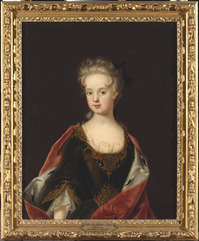Marie Leszczyńska facts for kids
Quick facts for kids Marie Leszczyńska |
|||||
|---|---|---|---|---|---|
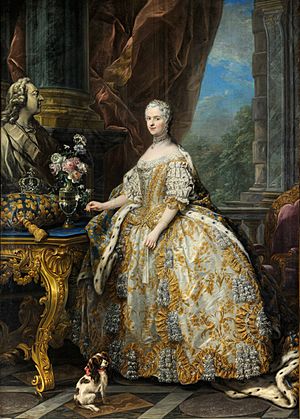
Portrait by Charles van Loo, 1747
|
|||||
| Queen consort of France | |||||
| Tenure | 4 September 1725 – 24 June 1768 | ||||
| Born | 23 June 1703 Trzebnica, Duchies of Silesia, Habsburg Monarchy (now Poland) |
||||
| Died | 24 June 1768 (aged 65) Versailles, Yvelines, Kingdom of France |
||||
| Burial | Basilica of St Denis, France | ||||
| Spouse | |||||
| Issue In detail |
|
||||
|
|||||
| House | Leszczyński | ||||
| Father | Stanisław Leszczyński | ||||
| Mother | Catherine Opalińska | ||||
| Religion | Roman Catholicism | ||||
| Signature |  |
||||
| Styles of Marie Leszczyńska |
|
|---|---|
 |
|
| Reference style | Her Majesty |
| Spoken style | Your Majesty |
| Alternative style | Most High, Most Potent and Excellent Princess |
Marie Leszczyńska (born Maria Karolina Zofia Felicja Leszczyńska; 23 June 1703 – 24 June 1768) was the Queen of France. She was married to King Louis XV from 1725 until her death in 1768. Her time as queen, lasting 42 years and 9 months, was the longest in French history.
Marie was the daughter of Stanisław Leszczyński, who was once the King of Poland, and Catherine Opalińska. She was a very religious Roman Catholic. The French people liked her because she did many good deeds for charity. She also brought some Polish customs to the royal court at Versailles. Marie was the grandmother of three future French kings: Louis XVI, Louis XVIII, and Charles X.
Contents
Early Life of Marie Leszczyńska
Marie Leszczyńska was born into the House of Leszczyński. She was the second daughter of Stanislaus I Leszczyński and Catherine Opalińska. Her older sister, Anna, sadly passed away in 1717.
Marie's early life was difficult because of her father's political problems. He lost his throne as King of Poland. This difficult situation, however, actually helped Marie become Queen of France. French leaders saw her as a good choice because her family had no strong political connections. This meant she would not bring complicated international alliances with her.
She was born in Trzebnica, a place in what is now Poland. Her father became King of Poland in 1704, but he was removed from power in 1709. This happened after the Swedish army, who had supported him, lost power in Poland.
Her family then found safety in Kristianstad, a city in Sweden. During their escape, Marie got separated from her family. She was later found hiding with her nurse. In Sweden, the royal family welcomed them. They became well-liked in the noble society around Kristianstad.
In 1712, they even visited a royal spa. During this time, Marie started speaking Swedish with a special accent. Later, as Queen of France, she would greet Swedish visitors with a Swedish phrase meaning "Welcome, Dearest Heart!"
In 1714, the family moved to Zweibrücken in the Holy Roman Empire. They lived there with money from the land until 1718. After that, they asked for help from the French Regent, Philippe II, Duke of Orléans.
With his support, they settled in Wissembourg in Alsace, France, in 1718. They lived a simple life in a large house. The French Regent paid for their living expenses. Their lifestyle was quite modest for a royal family.
Marie's mother and grandmother were sometimes upset about losing their royal position. They sometimes blamed Stanislaus for their exile. However, Marie was very close to her father. She spent a lot of time talking with him.
She was known for being calm and not complaining about her problems. People said she had a "deep and strong religious faith." This faith helped her mature and accept her life without always seeking happiness.
Marriage to King Louis XV
Early Marriage Talks
Marie was not known for her beauty. Instead, she was seen as pleasant, well-educated, and graceful. In 1720, she was suggested as a bride for Louis Henri, Duke of Bourbon. However, his mother did not agree to the marriage.
An officer named Marquis de Courtanvaux fell in love with Marie. He asked the Regent to make him a duke so he could marry her. But the Regent refused, and his low rank made the marriage impossible. Other proposals for marriage also failed, often because Marie did not have enough money for a dowry.
Becoming Queen of France

In 1723, the Duke of Bourbon became the Regent of France. He was in charge while King Louis XV was still young. The Duke was greatly influenced by his friend, Madame de Prie. At first, they considered Marie for the Duke himself. Madame de Prie liked Marie because she didn't see her as a threat.
Soon, marrying King Louis XV became the main goal. The King, who was fifteen, became ill. People worried he might die without a child to take his place. So, the Duke suggested he marry quickly. The King was already engaged to a five-year-old Spanish princess. But she was too young to have children soon.
The engagement was broken off, and the Spanish princess was sent home. This upset Spain. The Duke of Bourbon and Madame de Prie then started talks for the King to marry Marie.
Marie was on a list of 99 possible princesses for the King. She was not the first choice. She was initially removed from the list because she was not wealthy enough. However, other choices had problems. For example, some princesses would have to change their religion.
Cardinal Fleury, the King's former teacher, did not want the King to marry a non-Catholic. He also did not want the King to marry the Duke of Bourbon's sisters. Marie was finally chosen because she was Catholic, healthy, and old enough to have children right away. She also had no strong political ties, which made her acceptable to all sides.
Madame de Prie reportedly had a flattering portrait of Marie painted. It made her look like the King's favorite picture of his mother. When the King saw it, he was very impressed. He said, "She is the loveliest of them all!" and became excited about the marriage.
The official proposal happened on April 2, 1725. The royal court was not happy about the news. They thought Marie was not important enough to be Queen of France. There were rumors that she was ugly or could not have children.
On May 6, 1725, Marie had to have a medical check-up. This proved she was healthy and could have children. Her marriage contract gave her money for jewels and a yearly allowance.
Life with Louis XV
The wedding happened on August 15, 1725, in Strasbourg. Louis XV was represented by his cousin. Marie's Polish name was changed to the French "Marie." People often used her Polish last name, even though it was hard to say.
Marie traveled with many people, but there were no big celebrations for her arrival. However, she made a good impression on the public. She gave out gifts to people on her way to the wedding.
Louis and Marie met on September 4, 1725, at the Château de Fontainebleau. Marie was 22, and Louis was 15. They reportedly fell in love right away. Their relationship was happy at first. For eight years, Louis XV was devoted to her. He was eager to marry her and did not allow anyone to criticize her looks.
In August 1727, Marie gave birth to twin daughters, Louise Élisabeth and Anne Henriette. The King was thrilled. He had been told he might not be able to have children. Cardinal Fleury, however, wanted a son. He decided Marie should stay at Versailles and not travel with the King until she had a son.
A year later, another daughter, Marie Louise, was born. Finally, the long-awaited son, Louis, was born on September 4, 1729. This brought great relief to the country.
Marie had ten children who were born alive, and seven lived to adulthood. Her daughters saw her as a very good role model. Marie herself was calm and did not show much outward affection to her children.
Marie was considered plain-looking by people at the time. But she had a fresh, healthy complexion. As she got older, she did not use makeup. She was shy and quiet around her husband. She felt it was her duty to show him respect. She found it hard to relax and entertain him. Once, she suggested he kill flies on the windowpanes to pass the time.
Louis XV often felt bored. He started to listen when others compared Marie to other women. Cardinal Fleury wanted to stop Marie from gaining influence over the King. He thought it was fine for the King to have other female companions, as long as they did not get involved in politics.
After the difficult birth of Princess Louise in 1737, doctors advised Marie that another pregnancy could be dangerous. From 1738, she no longer shared a bedroom with Louis.
The King then began to spend time with other women. His relationship with Marie became mostly formal. They still appeared together for official events. The King only visited her rooms for formal reasons and no longer played cards with her. The court noticed her loss of the King's close affection.
Madame de Pompadour became very important at court in 1745. She had a lot of influence until her death in 1764. She was so important that she sometimes overshadowed the Queen. The King's companions were often given roles in Marie's court. This gave them an official reason to be there, which was difficult for Marie.
Marie found the first official companion, Louise Julie de Mailly, the most hurtful. But she disliked Marie Anne de Mailly more personally, as Marie Anne was often rude. Marie had a fairly friendly relationship with Madame de Pompadour. Pompadour always treated the Queen with respect. Marie herself never had relationships outside her marriage.
Queen of France
Political Role
Queen Marie never gained much political power. After her marriage, many people in her court were followers of the Duke of Bourbon. Cardinal Fleury, the King's former tutor, was also part of her court.
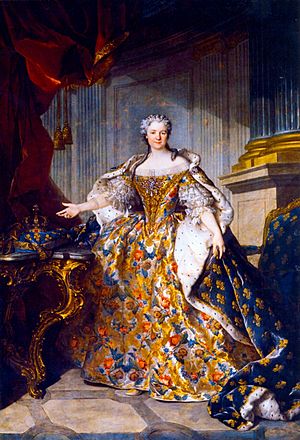
Marie's father had told her to always support the Duke of Bourbon. So, Marie tried to get involved in politics to help him. In December 1725, the Duke of Bourbon and his allies tried to remove Cardinal Fleury from power. They asked the Queen to call the King to her rooms. There, they tried to blame Fleury for a problem with the Pope.
However, Cardinal Fleury found out about the plan. He left the palace. The Duke and his allies wanted Marie to tell the King that Fleury wanted to leave his job. This led to a crisis. The King told the Duke of Bourbon to either remove his allies or lose his job as prime minister. This event made Cardinal Fleury see Queen Marie as an opponent.
In June 1726, Fleury convinced the King to remove the Duke of Bourbon from his position. Madame de Prie immediately asked the Queen to speak to the King for Bourbon. Marie agreed and spoke passionately to the King. But she failed because the King reacted negatively to her trying to get involved in politics. Cardinal Fleury had already warned the King not to let women influence state affairs.
The day after the Duke of Bourbon lost his job, Louis XV told Queen Marie: "I ask, Madame, and, if necessary, I order you to believe everything that the former Archbishop of Frejus tells you on my behalf, as though he were I – Louis."
Marie's attempt to get involved in politics in 1726 caused problems with Louis XV. She asked for advice on how to behave. She was told that as Queen, her duty was to be a good example of virtue and faith, not to get involved in political plots. Marie accepted this advice. She never again took part in political activities.

Marie became friendly with Cardinal Fleury. She wrote to him and asked for his advice on how to please the King. Fleury often helped her when her requests to the King were harmless. For example, in 1742, he helped her appoint a friend to a court position. After 1726, her political actions were limited to asking Louis XV to help friends with pensions or promotions. She often used Cardinal Fleury to help with this.
Even without direct influence, she had her own political views. During the War of the Polish Succession (1733–1736), she supported her father's claim to the Polish throne. She encouraged Cardinal Fleury to help her father. She told the Cardinal that she never wanted the war. She felt she was an innocent reason for it because France wanted to improve her family's status.
After the war, her father was given the Duchy of Lorraine. This was because he was the King of France's father-in-law. When her father died, Lorraine became part of France. This showed how Marie, indirectly, was useful in politics. As a religious Catholic, Queen Marie supported the religious party at court. She also sympathized with the Jesuit order. If the King had died before his son was an adult, Marie would have become regent until her son's 13th birthday. This was a known fact at court.
Role as Queen
At first, the royal court did not respect Queen Marie. They saw her as having a lower social status. She had no powerful family connections, so she lacked political power. She was not seen as personally important.
As queen, Marie Leszczyńska followed all the strict rules of court life. She performed all her official duties at Versailles regularly. She valued these formal ceremonies to gain respect from the court nobles. This was important because she did not come from a powerful royal family. Later, Queen Marie Antoinette would ignore many of these rules. She felt she did not need to prove her status because her royal birth was clear.
Marie received money for her personal use, charity, and gambling. This money was often not paid on time and was not enough. She often owed money. Her apartments at Versailles were not redecorated after 1737. Her favorite card game, cavagnole, often put her in debt. The King usually did not pay these debts for her.
She accepted that her court staff were chosen by rank, not by her personal preference. She spoke politely with everyone. However, after her official duties, she preferred to retreat to her private rooms. There, she spent time with a small group of close friends. These friends included Cardinal de Luynes and her chief lady-in-waiting, Marie Brûlart. She also befriended the wealthy widow of the former Regent, Francoise Marie de Bourbon.
Queen Marie eventually earned the respect of the court nobles by strictly following etiquette. This made her opinion formally important. In 1747, the writer Voltaire was banned from the royal court because of her. This happened after two incidents where he insulted the Queen.
During a long night of gambling, Voltaire's friend lost a lot of money at the Queen's table. Voltaire whispered in English that she had been cheated. This was seen as an insult to the Queen and her guests. Soon after, Voltaire wrote a poem praising the King's companion, Madame de Pompadour. This also offended Marie, leading to Voltaire's banishment.
When her first daughter-in-law died in 1746, the Queen was very fond of her only son. She did not want him to marry his next wife, Duchess Marie-Josèphe of Saxony. This was because Marie-Josèphe was the daughter of her father's rival, King Augustus III of Poland. Her dislike was known but ignored, as she had no strong family connections.
At first, this caused some tension between Marie and her new daughter-in-law. But they soon got along well. Marie-Josèphe admired the Queen's father. Because of this, several of the Queen's grandsons were named Stanislaus (Stanislas in French).
Marie supported artists and musicians. She was a patron of the painter Jean-Marc Nattier. In 1748, she asked him to paint her last portrait. It was an informal painting and became very popular. She loved it and had copies made for her friends. She loved music and painting. She met the famous singer Farinelli in 1737. She also met the young Mozart in 1764, whom she found charming. She even translated for her family when Mozart visited Versailles. Her main contribution to life at Versailles was her weekly Polish choir concerts.
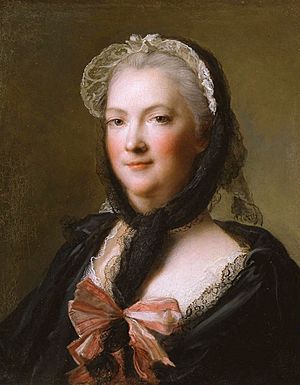
Queen Marie kept her reputation as a simple and religious Catholic queen. She was a great example of Catholic faith. She was known for her kindness to the poor. She gave money, started workhouses, and helped people find ways to earn a living. She also supported orphanages and hospitals. This made her very popular with the public throughout her life as Queen.
Death and Burial
Marie Leszczyńska passed away on June 24, 1768, one day after her 65th birthday. She was very popular with the public both in her early and later years. She was buried at the Basilica of St Denis in France. Her heart was buried in the Church of Notre-Dame-de-Bonsecours in Nancy.
Children
| Name | Portrait | Lifespan | Notes |
|---|---|---|---|
| Marie Louise Élisabeth Duchess of Parma |
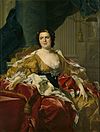 |
14 August 1727 – 6 December 1759 |
Married Philip, Duke of Parma. They had children. |
| Anne Henriette |  |
14 August 1727 – 10 February 1752 |
Died at age 24. She did not marry or have children. |
| Marie Louise |  |
28 July 1728 – 19 February 1733 |
Died as a young child. She had no children. |
| Louis, Dauphin of France |  |
4 September 1729 – 20 December 1765 |
Married María Teresa Rafaela of Spain and had children. After she died, he married Maria Josepha of Saxony and had more children. |
| Philippe Louis, Duke of Anjou |  |
30 August 1730 – 7 April 1733 |
Died as a young child. He had no children. |
| Marie Adélaïde |  |
23 March 1732 – 27 February 1800 |
Died at age 67. She did not marry or have children. |
| Victoire Louise Marie Thérèse | 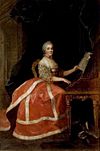 |
11 May 1733 – 7 June 1799 |
Died at age 66. She did not marry or have children. |
| Sophie Philippine Élisabeth Justine Fille de France |
 |
27 July 1734 – 2 March 1782 |
Died at age 47. She did not marry or have children. |
| Marie Thérèse Félicité | 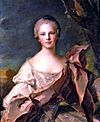 |
16 May 1736 – 28 September 1744 |
Died as a young child. She had no children. |
| Louise-Marie | 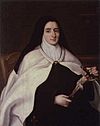 |
15 July 1737 – 23 December 1787 |
Died at age 50. She did not marry or have children. |
See also
 In Spanish: María Leszczyńska para niños
In Spanish: María Leszczyńska para niños


